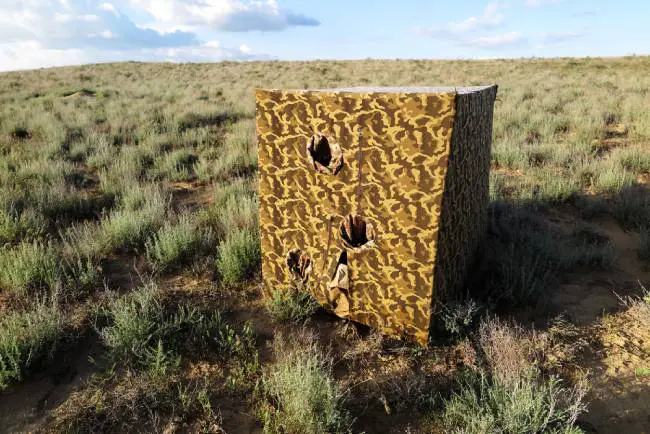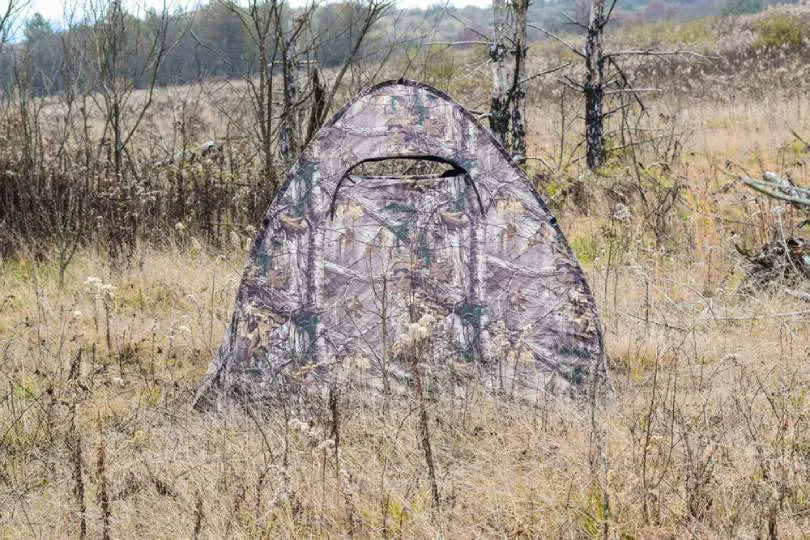A ground blind for hunting allows you to get closer to your prey while remaining out of their sight, scent, and hearing. It is a movable shelter that you can use to hide from the prey. This sort of blind often has a camo cloth cover and shooting windows or openings. These can significantly improve your hunting experience. So, how to set up a ground blind for hunting?
Setting up a good ground blind is not so difficult if you know what you are doing. You can follow a few simple steps and complete setting up your ground blind. You need to pick a spot, set up the blind and add a few finishing touches.
So how do you do these things? Keep reading this blog post to find out.
Choosing a Location for Setting Up Ground Blind
The first step to setting up a ground blind is choosing a location that matches your hunting goals and conditions. Here are some things to think about when picking a spot for your ground blind:
- Wind direction: You don’t want to put your blind downwind of where you think the animals will come from, because they might smell you and run away. You also don’t want to put your blind in an area where the wind changes a lot or unpredictably, because this might confuse or alert the animals. The best thing is to put your blind upwind or crosswind of where you think the animals will come from, and check the wind direction often with a wind indicator or a piece of thread.
- Visibility: You want to pick a location where you have a good view of your surroundings. And that so without being too obvious or exposed. For that, you don’t want to put your blind in the direct sunlight or against the skyline. Because, this could create silhouettes or glare and reveal your position. The ideal place where you want to put your blind is an area that has some natural shade and cover such as hills, trees, bushes or rocks.
- Animal activity: Place your blind in an area where there are indicators of animal presence and movement, such as tracks, trails, droppings, rubs, scrapes, or bedding places. You should also avoid placing your blind in areas where there is evidence of human disturbance or predators, like as roads, fences, rubbish, or corpses. The ideal option is to place your blind near food supplies, water sources, or transit routes that the animals use and often.
- Access: You want to be able to enter and exit your blind silently and effortlessly, without leaving behind too much fragrance or noise. Do not put your blind in a place that is too distant or too difficult to get from your car or campground, as this may tire you out or lead you to be late for your hunt. Set your blind in an area with a clear and discrete path that you may utilize before and after your hunt.
Once you have found a good location for your ground blind, scout and prepare the area before setting up the blind. This might include cutting any branches or weeds that are blocking your vision or shot, clipping some foliage that matches your camo pattern, or raking some leaves or dirt that are covering your smell.
How to Set Up a Ground Blind

This is the most important step on how to set up a ground blind. In this step, you need to put together and secure the blind according to the instructions provided by the manufacturer. Follow these steps to do so:
- Unfold: Take your blind out of its carrying bag and unfold it on the ground. Check that it is fully stretched and that all of the poles are securely fastened.
- Pop-out: Lift up the roof of the blind and push out the hubs until they click into position. Check that the cloth is tight and smooth on all sides.
- Anchor: Use the stakes provided or some rocks or sticks to secure the blind’s corners. For stability, make sure the stakes are pushed deep into the ground and angled away from the blind.
- Camouflage: Add some natural materials such as grasses, branches, or leaves to the brush holders or loops on the outside of the blind. Ensure they blend nicely with the surroundings and do not block any entrances or windows.
You may need some tools as well as accessories to set up your blind. You can include a hammer, rope, brush holder and chair in your list. The hammer will come in handy when you need to drive stakes into the hard ground. You can use the rope to tie down the blind if the conditions get windy.
The brush holder will help you attach more natural materials to the outside of the blind. And having a chair will give you a place to sit comfortably and quietly while you wait for the prey.
Adding Finishing Touches to Your Ground Blind
The third step to setting up a ground blind is adding some finishing touches that will improve your comfort and concealment inside the blind. Here are some ways to do that:
- Adjust the windows: Open or close the windows based on your preferences and the weather conditions. Make sure you have proper ventilation and visibility, as well as appropriate darkness and cover. You may change the windows silently and effortlessly by using the zippers, magnets, hooks, or straps.
- Add cushions: Bring pillows or mats to sit on or lean on while within the blind. This will make you more comfortable while also decreasing weariness and noise. You may also use blankets or sleeping bags to keep warm and comfortable.
- Use scent eliminators: Before and after your hunt, spray smell eliminators or deodorizers on yourself, your gear, and your blind. This will assist to hide your human stench and keep the animals away from you. To blend in with the surroundings, employ natural odors such as pine needles or dirt.
- Wear appropriate clothing: You can cover your skin with gloves, caps, masks, or facial paint to decrease glare. Wear clothes that coordinate with the camo design and color of your blind as well as the season. This will allow you to remain hidden and comfortable within the blind.
There are some things that you should take with you to make your hunting experience more enjoyable as well as successful.
- Binoculars: To see the area and spot targets from a distance.
- Rangefinder: To Measure the distance and angle of your shot accurately.
- Snacks: To stay energized throughout the time.
- Water: It is a must to prevent dehydration during hunting and quench your thirst.
- First aid kit: You should always keep one of these when you go to hunt. You never know when you need one.
Some Rules and Ethics to Follow When Hunting
While using a hunting blind, always learn and adhere to the hunting rules and ethics that apply to your region and game. This might include:
- Obtaining a hunting license: In order to hunt legally and responsibly in your state or province.
- Getting permission: To hunt on someone else’s private or public land.
- Respecting boundaries: Boundaries must be respected in order to avoid trespassing or interfering with other hunters or landowners.
- Target identification: To avoid shooting at anything that is not your intended animal or is beyond your ability level.
- Recovering animals: Animal recovery entails tracking down and retrieving any animals that have been shot or injured as swiftly and compassionately as possible.
Conclusion
Learning how to set up a ground blind will help you to have a better hunting experience and increase your success rate. With the abovementioned steps and tips, you should be able to properly set up your hiding spot and spot the animals from there.
Just remember to keep the basic necessities such as water, food, and first aid kit with you in case of any emergency. And if you are hunting alone, let someone know where you will be setting up your ground blind.









Leave a Comment